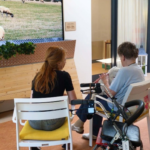The well-being of people with dementia (PWD) living in long-term care facilities is hindered due to disengagement and social isolation. Animal-like social robots are increasingly used in dementia care as they can provide companionship and engage PWD in meaningful activities. While most previous human–robot interaction (HRI) research studied engagement independent from the context, recent findings indicate that the context of HRI sessions has an impact on user engagement. This study aims to explore the effects of contextual interactions between PWD and a social robot embedded in the augmented responsive environment. Three experimental conditions were compared: reactive context-enhanced robot interaction; dynamic context-enhanced interaction with a static robot; a control condition with only the dynamic context presented. Effectiveness evaluations were performed with 16 participants using four observational rating scales on observed engagement, affective states, and apathy related behaviors. Findings suggested that the higher level of interactivity of a social robot and the interactive contextualized feedback helped capture and maintain users’ attention during engagement; however, it did not significantly improve their positive affective states. Additionally, the presence of either a static or a proactive robot reduced apathy-related behaviors by facilitating purposeful activities, thus, motivating behavioral engagement.
Effects of the Level of Interactivity of a Social Robot and the Response of the Augmented Reality Display in Contextual Interactions of People with Dementia
Y. Feng, E. I. Barakova, S. Yu, J. Hu, and G. Rauterberg, “Effects of the Level of Interactivity of a Social Robot and the Response of the Augmented Reality Display in Contextual Interactions of People with Dementia,” Sensors, vol. 20, no. 13, pp. 3771, 2020.
FULLTEXT: PDF REFERENCE: BibTeX EndNote
DOI: 10.3390/s20133771
